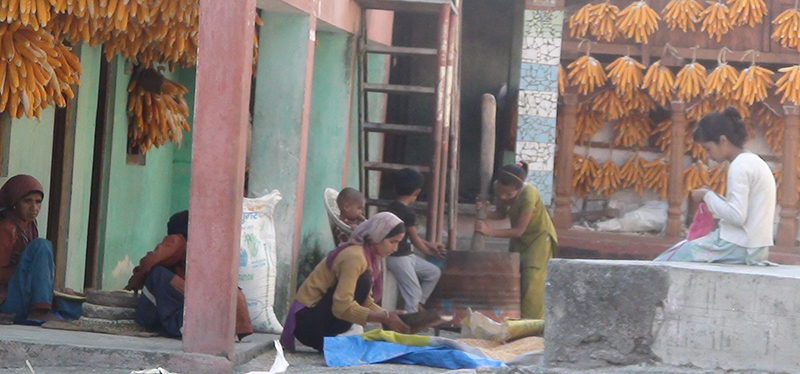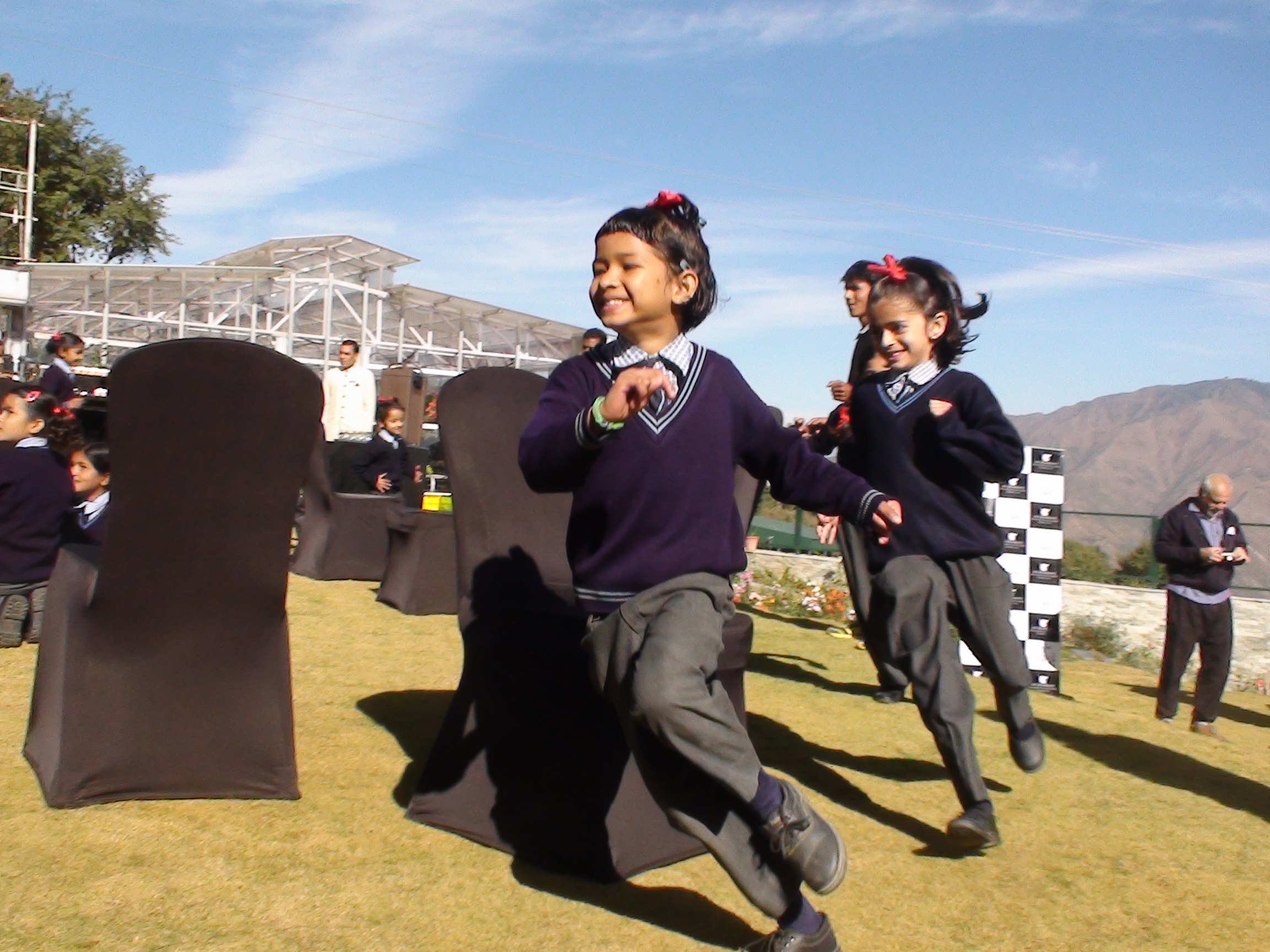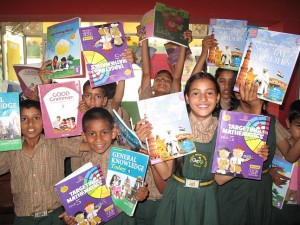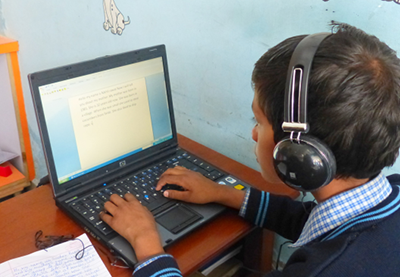Our History
“Good morning Aunty”, my fourth graders all stand up as I enter the class room. “Good morning everyone”, I answer. “Aunty you gave us homework yesterday.” They remind me. “Yes, and was it difficult?” I ask. “No Aunty, not difficult. It was easy!” They all shout. “Ok then, lets go over it now.”
I look around the classroom at all 25 little faces. Some of them have been with me since class one, some are new additions this year. They are all so eager to learn, all have such bright futures ahead of them. We began with 8 students in our little school in 2009, and now we have 165. How did we ever manage to get this far I marvel. I always have to pinch myself to make sure I am not dreaming.
In 2007 , I stood on the road above the village of Sainji, nestled in the foothills of the Indian Himalaya and marveled at its beauty, and wondered what it would be like to live in such a place. A higher power must have heard my musings because not long after, I met my husband, a native villager from this very village and a long time respected community member. Soon we were married and I became a member of this village and all its’ struggles. Everyday we pay witness to the extremes of poverty, and all the misery poverty entails.
, I stood on the road above the village of Sainji, nestled in the foothills of the Indian Himalaya and marveled at its beauty, and wondered what it would be like to live in such a place. A higher power must have heard my musings because not long after, I met my husband, a native villager from this very village and a long time respected community member. Soon we were married and I became a member of this village and all its’ struggles. Everyday we pay witness to the extremes of poverty, and all the misery poverty entails.
In 2009 ago my husband and I decided to start a school here, not just any school, but an English Medium School that would offer our village children an excellent education and a fighting chance to better their lives so they would not have to struggle to survive in the same harsh way their parents have had to. This came about after we had been checking exam results on the internet for our high school children. In India, students have home exams until ninth grade and at high school they have to write state or national open or board exams to get into the 11th standard. Our children’s marks were in the 30-40% range, and yet they were happy because all you needed was 33% to pass.
There is much ground to cover in the hill districts with respect to development and education. Agriculture is no longer a sustainable means of supporting a family. With climate change crops are failing and yields are not as large.
Families need an income, and yet there are virtually no industries or viable means of employment to sustain a family when the wage earner is poorly educated. People in our region recognize that the best solution, the only one that makes any sense, is to provide the children with quality education. When speaking to others from the Garhwal region about education the response was always the same, “Oh you should open a school in our area. We desperately need a good school for our children”. And then we listened to the familiar story of poverty, the high rate of out migration of poorly educated adolescents to the cities where they join the surmounting number of poorly educated slum dwellers, or of girls whose only hope for a good life is that she marry into a good family, and not have to endure the backbreaking labour her mother has had to cope with.
The problem with schools for the poor in the hill districts stems from a lack of commitment to good education by government and private schools alike. Given the difficult terrain of the hill areas teacher absenteeism is among the highest in the country. This is coupled with rigid teaching practices and a lackluster approach to teaching by the teachers. In recent years, in order to stem the number of drop outs and curb the number of children entering child labour, the Indian government has adopted a ‘pass the child through no matter what their grade’ policy. This leaves little incentive for teachers to actually ‘teach’. This is coupled with an attitude amongst many teachers that the children of the hills are ‘unteachable’. As many teachers whom we interviewed commented, ‘Oh those children don’t want to learn. They come to school, but their minds are only on their fields and their cow sheds.’ Non Government Organizations (NGOs) generally cannot afford the high wages government schools pay. Hence, they hire non-certified teachers. Most of these teachers are committed and well meaning individuals, but poorly educated themselves. Hence, their ability to pass on knowledge to their young students is restricted. Most teach by the same method by which they were taught – by standing at the front of a classroom, text book in hand requesting the children recite and memorize. This method is used in the government schools as well, along with corporal punishment. One day I saw a teacher wind up and slap a little girl across the face – so hard that the child nearly fell off her chair. Once the child regained her balance the teacher slapped her again.
One has to wonder, when applying such rigid methods, how many children are left behind? What about the child who is dyslexic, or has Attention Deficit Disorder? Who struggles to memorize? Who is hearing impaired? Those who are slower to understand concepts or who need to see and touch in order to understand? The teaching profession in India needs to recognize the many different ways that young minds are wired. I believe the challenge for us as teachers is to find the method that best fits the child. I love those ‘light bulb’ moments when I see a child who has been struggling to understand a concept, finally ‘get it.’
Given the state of education in our area, Kunwar and I decided to open an English Medium School which would include computer classes in its curriculum. Children who can speak English and who are computer literate have an upper hand in getting into good universities and securing better paying jobs. However, these skills alone are still not enough. Children need to have quality education in order to succeed. Every day we are accepting new children – all coming from a range of schools and learning experiences. It used to surprise me initially that our children could recite their multiplication tables, but were not able to answer 3×7 when it was out of context, or even add 7 + 4. Tactile, visualization techniques were not a part of their previous learning experiences.
Both Kunwar and I realized early on that we needed to incorporate methods to build mental skills thus allowing the children to visualize concepts. We incorporate projects that encourage the children to work through problems so they develop understanding through doing and feel the sense of accomplishment once they have mastered a task. For our children, this technique has paid off tremendously. Children who were labeled in their previous schools as ‘unteachable’ are excelling and gaining tremendous confidence as a result. As teachers, we need to recognize that every child is different and that they learn in different ways and it is our job to find the way to teach to each and every one of them. This can only be accomplished through small class sizes where the children receive one on one interaction with the teacher. I also believe that when we capture a child’s interest, there is no limit to what they can achieve. If the teacher does not have the full attention of all the students, then they need to change their approach so each and every one of the children is engaged in the learning process. At the same time, the child needs to feel that mastering a skill is their own discovery, their own mastery – this builds confidence which gives them permission to reach out and learn more.
 Education in impoverished areas such as ours however, requires more than good teaching methods and books. In our experience, we have had to work on all levels with our children. This includes providing good nutrition through a lunch time meal, and vitamins to supplement their otherwise poor diets in their homes. Most children tell us they have chai and biscuits for breakfast, and roti and rice for dinner. Only two or three times a week do they eat dahl. Vegetables are eaten sporadically throughout the year. Most of our new children are suffering from protein and vitamin deficiency (mostly vitamin D).
Education in impoverished areas such as ours however, requires more than good teaching methods and books. In our experience, we have had to work on all levels with our children. This includes providing good nutrition through a lunch time meal, and vitamins to supplement their otherwise poor diets in their homes. Most children tell us they have chai and biscuits for breakfast, and roti and rice for dinner. Only two or three times a week do they eat dahl. Vegetables are eaten sporadically throughout the year. Most of our new children are suffering from protein and vitamin deficiency (mostly vitamin D).
At the same time we outfit our children with school uniforms. Thanks to donations from good hearted people we have been able to provide our children with shoes, socks, underwear and inner wear for the colder months, hats, and even rain coats for the monsoon season. We believe that in order to function to their full potential, a child should look and feel good too. Through donations we have also been able to provide our children with books, sports toys and track suits, stationary supplies, and computer aids.
Since 2009 our school has grown from 8 students to 165. Currently, over half of our children are speaking, reading and writing in English. Our children work hard, because they know they have to. When  we first began I would to ask them what they would be when they grew up. The response was, “A gatekeeper, an army man, a mommy, a hotel worker, and so on. Their dreams were small. But over time, they have come to realize that with good education and hard work anything is possible. Ask any of our children today what they want to be when they grow up and they will tell you, “An engineer, a doctor, a lawyer, a pilot, a teacher, a businessperson.” Many believe that the Indian economy is supported by the uneducated, poorly paid laborers that make up almost half the Indian population. India’s population now stands at 1.2 billion people. Imagine an India with 1.2 billion well educated people. What are the possibilities? What if Gandhi had not received the education he did? What would India be today? I look around at our children and I wonder what they will become in 20 years? Perhaps one will come up with the cure for cancer; be among the first astronauts to travel to Jupiter; negotiate peace settlements with warring countries; or return to this region with innovative strategies to improve the quality of life in the villages. With a good education the possibilities are endless.
we first began I would to ask them what they would be when they grew up. The response was, “A gatekeeper, an army man, a mommy, a hotel worker, and so on. Their dreams were small. But over time, they have come to realize that with good education and hard work anything is possible. Ask any of our children today what they want to be when they grow up and they will tell you, “An engineer, a doctor, a lawyer, a pilot, a teacher, a businessperson.” Many believe that the Indian economy is supported by the uneducated, poorly paid laborers that make up almost half the Indian population. India’s population now stands at 1.2 billion people. Imagine an India with 1.2 billion well educated people. What are the possibilities? What if Gandhi had not received the education he did? What would India be today? I look around at our children and I wonder what they will become in 20 years? Perhaps one will come up with the cure for cancer; be among the first astronauts to travel to Jupiter; negotiate peace settlements with warring countries; or return to this region with innovative strategies to improve the quality of life in the villages. With a good education the possibilities are endless.
